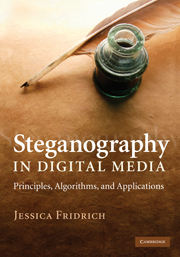Book contents
- Frontmatter
- Dedication
- Contents
- Preface
- Acknowledgments
- 1 Introduction
- 2 Digital image formats
- 3 Digital image acquisition
- 4 Steganographic channel
- 5 Naive steganography
- 6 Steganographic security
- 7 Practical steganographic methods
- 8 Matrix embedding
- 9 Non-shared selection channel
- 10 Steganalysis
- 11 Selected targeted attacks
- 12 Blind steganalysis
- 13 Steganographic capacity
- A Statistics
- B Information theory
- C Linear codes
- D Signal detection and estimation
- E Support vector machines
- Notation and symbols
- Glossary
- References
- Index
- Plate section
12 - Blind steganalysis
Published online by Cambridge University Press: 05 April 2014
- Frontmatter
- Dedication
- Contents
- Preface
- Acknowledgments
- 1 Introduction
- 2 Digital image formats
- 3 Digital image acquisition
- 4 Steganographic channel
- 5 Naive steganography
- 6 Steganographic security
- 7 Practical steganographic methods
- 8 Matrix embedding
- 9 Non-shared selection channel
- 10 Steganalysis
- 11 Selected targeted attacks
- 12 Blind steganalysis
- 13 Steganographic capacity
- A Statistics
- B Information theory
- C Linear codes
- D Signal detection and estimation
- E Support vector machines
- Notation and symbols
- Glossary
- References
- Index
- Plate section
Summary
The goal of steganalysis is to detect the presence of secretly embedded messages. Depending on how much information the warden has about the steganographic channel she is trying to attack, the detection problem can accept many different forms. In the previous chapter, we dealt with the situation when the warden knows the steganographic method that Alice and Bob might be using. With this knowledge, Eve can tailor her steganalysis to the particular steganographic channel using several strategies outlined in Section 10.3. If Eve has no information about the steganographic method, she needs blind steganalysis capable of detecting as wide a spectrum of steganographic methods as possible. Design and implementation of practical blind steganalysis detectors is the subject of this chapter.
The first and most fundamental step for Eve is to accept a model of cover images and represent each image using a vector of features. In contrast to targeted steganalysis, where a single feature (e.g., an estimate of message length) was often enough to construct an accurate detector, blind steganalysis by definition requires many features. This is because the role of features in blind steganalysis is significantly more fundamental – in theory they need to capture all possible patterns natural images follow so that every embedding method the prisoners can devise disturbs at least some of the features. In Section 10.4, we loosely formulated this requirement as completeness of the feature space and outlined possible strategies for constructing good features.
- Type
- Chapter
- Information
- Steganography in Digital MediaPrinciples, Algorithms, and Applications, pp. 251 - 276Publisher: Cambridge University PressPrint publication year: 2009



